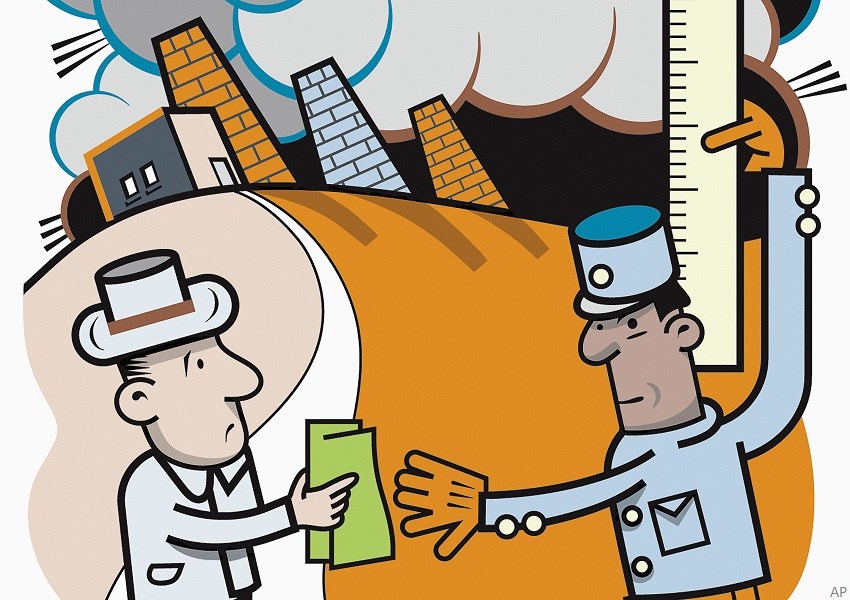
Taxes to level the playing field between “dirty” and “clean” companies likely to be implemented in the European Union, the United States and Canada will be seen on product price tags – and could affect your investments.
On July 14, the European Commission officially proposed a carbon border tax (CBT) that would apply to four carbon-intensive sectors: steel, aluminum, cement and fertilizers. Imports from these sectors would fall under the European Union Emissions Trading System (EU ETS) and be subject to a carbon price equivalent to what would be paid in the EU by domestic companies.
“Once countries begin placing a price on carbon,” says Simon MacMahon, head of ESG and corporate governance research at Sustainalytics, a division of Morningstar, “it inevitably leads to competitive disparities that will necessitate countries to place carbon border adjustments on goods being imported.”
Saving Steel in Europe?
The new EU tax should be enforced in two phases, explains Angelo Katsoras, geopolitical analyst at National Bank of Canada, in a recent report titled ‘Geopolitical Briefing: Is a carbon border tax inevitable?’. From 2023 to 2025, the carbon footprint of imports from the targeted sectors would be measured. Then, starting in 2026, a tax would be levied. “Over time, the aim is to apply the tax to other sectors,” notes Katsoras.
As major European players are pushing to compress this timeline, ArcelorMittal’s CEO recently warned: “It is critical to ensure that there is a level playing field, otherwise the steel industry will not survive in Europe.”
A First in the U.S.
The U.S. has long opposed a CBT, but support could be building quickly, as the recent E.U.-U.S. Steel Agreement would lead one to believe. A distinctive feature of the deal is that it can be implemented by presidential executive order, without needing to present it to Congress. On October 31, the two foremost economic zones signed the “ground-breaking” deal, as Katsoras characterizes it, that links carbon emissions to the steel trade and which should be implemented over the next two years. “It entails the two sides reducing tariffs reciprocally and eventually taking measures to exclude imports from other countries that fail to hit the standards for low-carbon steel production.”
This is not quite a CBT... but it acts like one. “It is a de facto border carbon tax,” Katsoras highlights. It also appears like protectionism, as U.S. President Joe Biden explained to reporters, “The new agreement would help restrict access to our markets for dirty steel from countries like China, and counter countries that dump steel in our markets, hammering our workers.”
How high the tariffs would reach is not yet settled. However, the Climate Leadership Council calculates that a carbon tariff of $55 would reduce steel imports to the U.S. by 50%.
Unsurprisingly, the deal receives full support from the U.S. steel industry and its unions “because the industry doesn’t have any market share in China and it hopes to increase its market share” in the U.S. and in Europe. As Katsoras notes, “the CBT has the potential to change the competitive positions of certain countries.”
Canada Tagging Along
As for Canada, “it is likely to enter into this climate-steel deal soon, Katsoras believes. Not only would this level the playing field for Canadian companies against competitors in regions with laxer environmental standards, it would also reduce the risk of seeing Canada on the receiving end of U.S. or EU climate-related sanctions.”
Both deals address industries at the commodity level, Katsoras explains, where there are fewer moving parts to analyze and tax. But other deals will expand CBTs to other industries, sector by sector, though which sectors are still unknown. And “this will get very complicated because it is not at all clear that all countries should be paying the same amount,” MacMahon points out.
Indeed, moving into more complex products, CBTs will require those ways of measuring the carbon footprint of components to be harmonized internationally. That is far from obvious. “China, in particular, could be reluctant to align itself with Western standards when it comes to measuring its carbon footprint, arguing that its own model is superior, Katsoras writes. Similar to what has occurred with 5G, internet and GPS standards, different environmental regulations could emerge in certain regions of the world.”
Carbon’s Complicated
Furthermore, when CBTs move to more elaborate industrial products and their logistical complexity, keeping track of all the moving parts could become an accountant’s nightmare. For example, some car parts move from China to Mexico, then to Europe, to the U.S., back to Mexico, and finally land in the U.S. or Europe. Follow that carbon trail if you can.
And that’s only the technical and accounting part of things. On the geopolitical side, this could cause commercial tensions to flare up. Challenges abound on that front. To begin with, China attacked the EU deal, saying that it violates global trade regulations, that it would aggravate tensions in industrial supplies and worsen “inflationary pressures”, Katsoras reports, who reminds us that developed economies are highly dependent on countless imports from China and elsewhere needed to implement their planned “energy transition”: solar panels, batteries, cobalt and rare earth minerals, among others.
Also, he adds, “The Paris Climate Accord allows for less stringent targets to apply for developing countries, whereas a CBT, in theory, would punish these very same countries for having weaker standards.” Also, while rich countries have failed to fulfill their promise to provide US$ 100 billion in loans and grants annually by 2020 to help poorer countries, China, India and Indonesia now view that amount as insufficient and are asking for US$ 1.3 trillion in annual transfers starting in 2030. Furthermore, a basic contradiction stands out, Katsoras notes: “Much of the reduction in emissions by the developed countries has been because many of them have outsourced their emissions (through factory production) to emerging countries”
How much CBTs (Carbon Border Taxes) will increase costs and general inflation remains to be seen, but Katsoras doesn’t doubt that they will. Starting from custom data tables supplied to Morningstar by StatCan, we tried to figure out the increase in costs and prices that CBTs would represent for industrial building construction, which consumes a lot of carbon-intensive inputs such as steel, aluminum and cement.
Add Up the Ingredients
In industrial buildings, imports represent 41% of steel consumed, 36% of aluminum consumed and 6% of cement consumed. In cars, import shares are 50% for steel and 27% for aluminum. Starting with a potential CBT of $55 per tonne of steel, representing a 6% increase on the basic price of $920 per tonne of steel, would lead to a 2.45% increase in the total cost of steel for the industry, according to calculations by an economist at the Canadian Construction Association (CCA) who asks for anonymity.
However, getting at a percentage increase for the total cost of a building requires a few assumptions, since the cost of steel only accounts for 16% of all materials cost of a building, also considering that raw steel represents only one-quarter of its installed cost once you factor in labour cost, the source at CCA points out. A very rough approximation would be an inflation of about 1.56% ((0.0245 x 0.16) ÷ 0.25 = 0.0156 x 100) in the total cost of a building, an inflation cost, the CCA believes, that would most likely be passed on to buyers since the demand for construction has a somewhat healthy elasticity (2.2 on average according to the Bank of Canada).
Inflation of 1.56% is not huge, but it involves steel alone in the single sector of industrial building construction. Factor in the cost of other materials (aluminum and cement) in that same industry as well as the cost of steel and aluminum in other sectors like car manufacturing, and you could probably end up with a not insignificant upward pressure on inflation. And that is notwithstanding other CBTs on other production materials in countless other industry sectors that will come along over the years.
In the meantime, investors should be alert to the challenges and opportunities CBTs will create. “Investors in steel and aluminum will need to analyze what companies stand to win and which stand to lose,” Katsoras advises. “Some players could gain larger market shares in their national markets and in developed economies.”




















